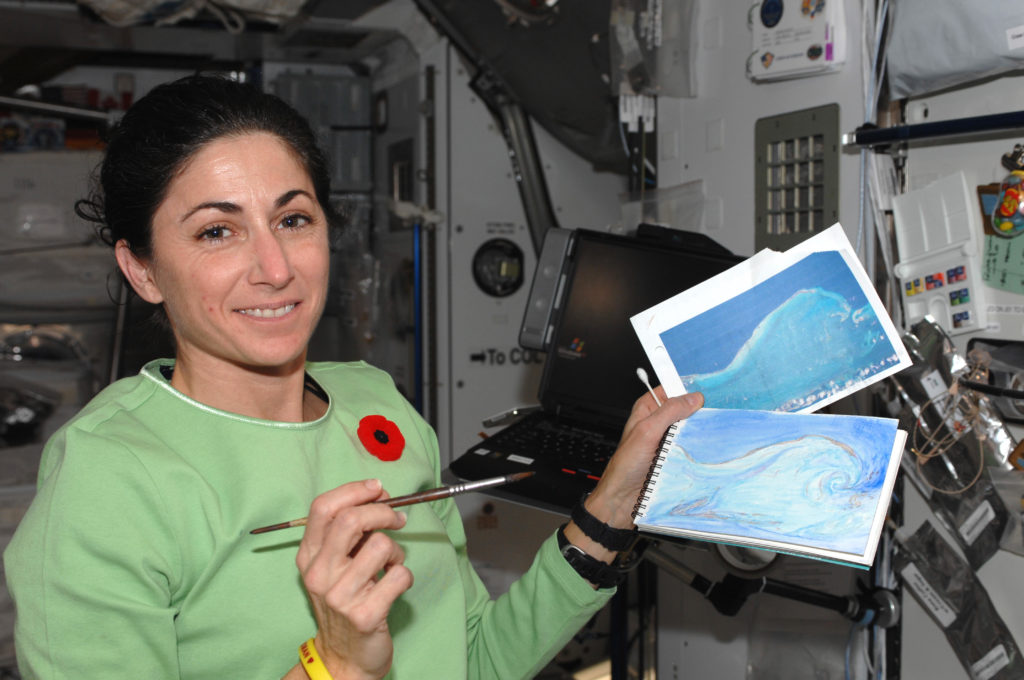Create
Astronaut artist Nicole Stott’s ‘Cosmic Impressionism’

Nicole Stott will never forget the evening of July 20, 1969. She was 6 years old, at home in front of the TV with her family in Clearwater, as Neil Armstrong and Buzz Aldrin walked on the moon. “I have a very vivid memory of eating that grilled cheese sandwich,” Stott says, “and then we went outside, looked up at the moon and said ‘There’s people up there ….’” The awe in the air made her shiver.
“But it never crossed my mind that it was something I could do. Not that somebody told me I couldn’t, but ‘That’s what some special person gets to do, not me.’”
Almost exactly 40 years later, Stott – pilot, scientist, engineer, astronaut, wife and mother – was launched into space as a crew member of the shuttle Discovery, which then docked at the International Space Station. Over the course of her two NASA flight missions, over six years, she logged a total of 104 days in space.
Floating above the planet at 17,500 miles per hour, she breathed in the brilliant blues and greens. “I don’t think you have to go to space to feel that we’re all inter-connected, that whole kind of thing, but it certainly is an excellent vantage point for that,” Stott says.
“When you look down, if you want to take a picture of something you’ve got to get it when it’s there, ‘cause it’ll be gone,” she explains.
Earth is whizzing by at a rate of five miles per second. “But it doesn’t feel like it’s spinning – you definitely know that it’s moving, but you don’t feel it’s a blur going by below you.”
Unlike previous astronauts who’d looked at little old Earth from the enormity of space, Stott didn’t think of humankind as tiny and insignificant. Quite the opposite.
“You look at the earth,” she explains, “and it’s a reality check: Oh my gosh, we live on a planet. We’re all earthlings! And the only border that matters is that blue line that blankets the whole thing. Those kinds of simple realities are in your face. And on top of that, it’s alive! It just glows – all the color of earth just glowing below you.”
During that first mission – ISS Expedition 21 – she became the first person to paint a watercolor in space.
The International Association of Astronomical Artists, of which Stott is a member, calls her unique work Cosmic Impressionism.
On her website, theartisticastronaut.com, Stott offers this mission statement: “Sharing this perspective has the power to increase everyone’s appreciation of and obligation to care for our home planet and each other.”
“The Wave,” the small painting she created on board the International Space Station (ISS), is a deeply impressionistic view of Isla Los Roques, a chain of islands located off the northern coast of Venezuela.
“I remember looking at it and thinking it’s like somebody had already taken a paintbrush and painted a wave on the ocean,” Stott explains.

October 2009: On board the ISS, with the photo and watercolor of Isla Los Roques.
As a highly-trained mission specialist, Stott was fully prepared for the complexities and challenges of living, working and co-existing with other crew members in space.
But there was more.
“All of being in space is a surreal thing,” she says. “Like, right now, I know I was there – but I’m thankful for the pictures and videos, because it just seems like something that shouldn’t be real.”
Going outside the ISS, for example, and tethering yourself to its fuselage. “Space walking is the step above that – ‘OK, now I’m outside of my space ship, in my own little space ship, crawling around.’ That’s where the total respect comes into play again – total diligence, total adhering to the communication protocol, awareness of what the condition of your suit is, and what’s going on around you.
“It’s also your responsibility not to get so engulfed in this overwhelmingly beautiful view that you don’t do your job when you’re out there.”
Creating a painting, similarly, took skill and focus. It couldn’t be done in real time, from the window – since the image doesn’t stay put. Instead, Stott photographed Isla Los Roques, and then attempted to paint from the photo on a handy sheet of scrap paper.
Which presented a new set of challenges.
“If I’d had brain cells I would have activated them and actually videotaped the whole process,” Stott laughs. “Because watercolor painting in space can describe the whole nuance of what living in space is like. Things float. You’ve got to be organized. You can’t just dip your brush into a cup of water. We drink out of these drink bags; they look like big Capri Sun bags, and they have a straw with a little valve on the end. So I would just squirt out these tiny little balls of water, then take the brush and touch it to the ball of water.
“But it was so cool, because even before the brush touched the water, it’s like the water was getting sucked onto the brush. Because of the way surface tension works up there.
“And then when you went to move the wet brush to the paint: Just before you got it there, the water was moving to the paint. And then the same thing coming off. You had to be really careful with how much pressure you put on to the paper, because the paper wanted to suck it all in! So you’re kind of dragging this blob of colored water along.” Cosmic impressionism, indeed.

“One of the greatest compliments I’ve ever received is when he called me a kindred spirit,” Stott says of Apollo 12 astronaut Alan Bean, a fellow space artist, who passed away May 26.
Back at home, Stott was befriended by Apollo 12 astronaut Alan Bean, the fourth man to walk on the moon. Bean had also dedicated much of his post-NASA life to re-creating his experiences through artwork. “All of us that have been fortunate enough to fly in space find it difficult to describe the beauty of our universe in words alone,” Bean said of his new colleague. “I am thankful that Nicole has chosen to help share these amazing sights we have all seen through her very beautiful artwork.”
Alan Bean died May 26, at the age of 86.
“One of the greatest compliments I’ve ever received is when he called me a kindred spirit,” Stott says. “I am so thankful for a mentor and friend like Alan Bean. I will always cherish his thoughtfulness and his wonderful smile, and we are all blessed by the legacy of his amazing artwork.”
Although she was in line to fly another mission, Stott retired from NASA in 2015. She figured she’d done everything she’d set out to do – and besides, her son Roman was just entering high school. Stott and her husband Chris thought it might be a good idea if everyone stayed in the same place for a while.
Will she ever take another trip into the void? “Ask me again when I’m 95,” she laughs.
As for her immediate legacy, “I never wanted to write the ‘Here’s how I became an astronaut’ book, because to me that ends at flying in space. To me, it’s about, how do I take that experience and do something with it?”
The answer, not surprisingly, was her artwork. As a public speaker, Stott can talk about her singular impressions of space, and her belief in a global community, while sharing her watercolors.
“I’ve always had this love for the intersection between science and art,” she muses. “For me, there’s not one or the other. It’s just this blend, and everybody has a different mix in them.”
Stott was one of the architects of the Spacesuit Art Project, an Arts in Medicine collaboration between NASA and The University of Texas MD Anderson Children’s Cancer Hospital.
Which was, in a way, just as fulfilling an experience as walking in space.

Official NASA photo.
Through her Space For Art foundation, she organizes exhibits and presentations of space exploration-related art (including hers) around the country. The first such exhibit launched in 2017, at the Johnson Space Center in Houston, with the full cooperation and blessing of NASA.
Painting that first watercolor, Stott explains, “was certainly a special thing to do, and it’s one of the highlights of my time there. But at the time I didn’t think this is going to be my mission, I’m going to use art to share the experience.”
Today, however, “I can communicate with audiences, through art, that might not ever think about space exploration, or a space station, or the fact that for 20 years we have had people living continuously in space, just above our planet, and not just from here in the U.S. – and doing it peacefully and successfully.”







